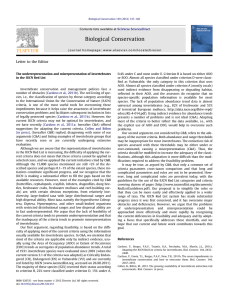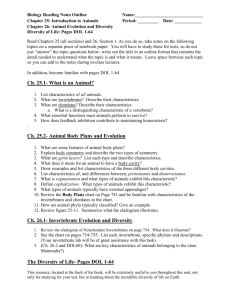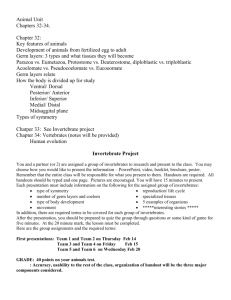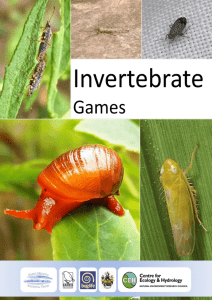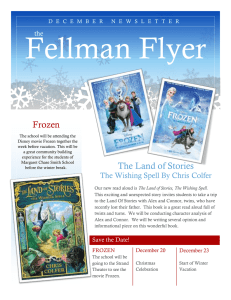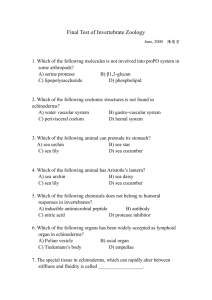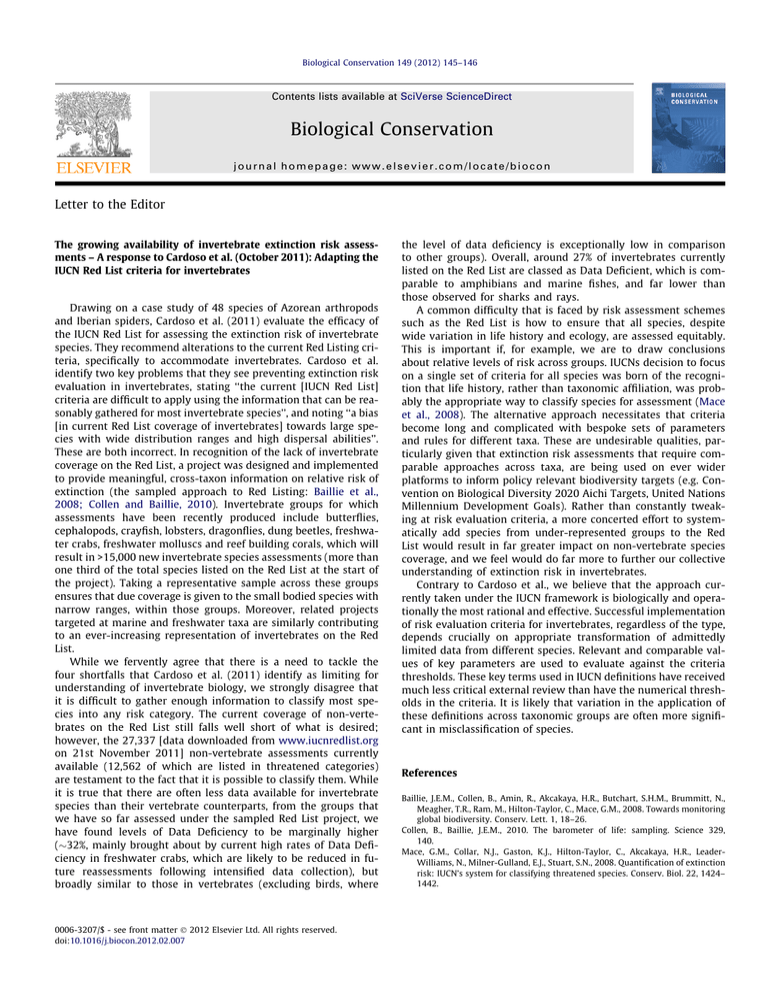
Biological Conservation 149 (2012) 145–146
Contents lists available at SciVerse ScienceDirect
Biological Conservation
journal homepage: www.elsevier.com/locate/biocon
Letter to the Editor
The growing availability of invertebrate extinction risk assessments – A response to Cardoso et al. (October 2011): Adapting the
IUCN Red List criteria for invertebrates
Drawing on a case study of 48 species of Azorean arthropods
and Iberian spiders, Cardoso et al. (2011) evaluate the efficacy of
the IUCN Red List for assessing the extinction risk of invertebrate
species. They recommend alterations to the current Red Listing criteria, specifically to accommodate invertebrates. Cardoso et al.
identify two key problems that they see preventing extinction risk
evaluation in invertebrates, stating ‘‘the current [IUCN Red List]
criteria are difficult to apply using the information that can be reasonably gathered for most invertebrate species’’, and noting ‘‘a bias
[in current Red List coverage of invertebrates] towards large species with wide distribution ranges and high dispersal abilities’’.
These are both incorrect. In recognition of the lack of invertebrate
coverage on the Red List, a project was designed and implemented
to provide meaningful, cross-taxon information on relative risk of
extinction (the sampled approach to Red Listing: Baillie et al.,
2008; Collen and Baillie, 2010). Invertebrate groups for which
assessments have been recently produced include butterflies,
cephalopods, crayfish, lobsters, dragonflies, dung beetles, freshwater crabs, freshwater molluscs and reef building corals, which will
result in >15,000 new invertebrate species assessments (more than
one third of the total species listed on the Red List at the start of
the project). Taking a representative sample across these groups
ensures that due coverage is given to the small bodied species with
narrow ranges, within those groups. Moreover, related projects
targeted at marine and freshwater taxa are similarly contributing
to an ever-increasing representation of invertebrates on the Red
List.
While we fervently agree that there is a need to tackle the
four shortfalls that Cardoso et al. (2011) identify as limiting for
understanding of invertebrate biology, we strongly disagree that
it is difficult to gather enough information to classify most species into any risk category. The current coverage of non-vertebrates on the Red List still falls well short of what is desired;
however, the 27,337 [data downloaded from www.iucnredlist.org
on 21st November 2011] non-vertebrate assessments currently
available (12,562 of which are listed in threatened categories)
are testament to the fact that it is possible to classify them. While
it is true that there are often less data available for invertebrate
species than their vertebrate counterparts, from the groups that
we have so far assessed under the sampled Red List project, we
have found levels of Data Deficiency to be marginally higher
(32%, mainly brought about by current high rates of Data Deficiency in freshwater crabs, which are likely to be reduced in future reassessments following intensified data collection), but
broadly similar to those in vertebrates (excluding birds, where
0006-3207/$ - see front matter Ó 2012 Elsevier Ltd. All rights reserved.
doi:10.1016/j.biocon.2012.02.007
the level of data deficiency is exceptionally low in comparison
to other groups). Overall, around 27% of invertebrates currently
listed on the Red List are classed as Data Deficient, which is comparable to amphibians and marine fishes, and far lower than
those observed for sharks and rays.
A common difficulty that is faced by risk assessment schemes
such as the Red List is how to ensure that all species, despite
wide variation in life history and ecology, are assessed equitably.
This is important if, for example, we are to draw conclusions
about relative levels of risk across groups. IUCNs decision to focus
on a single set of criteria for all species was born of the recognition that life history, rather than taxonomic affiliation, was probably the appropriate way to classify species for assessment (Mace
et al., 2008). The alternative approach necessitates that criteria
become long and complicated with bespoke sets of parameters
and rules for different taxa. These are undesirable qualities, particularly given that extinction risk assessments that require comparable approaches across taxa, are being used on ever wider
platforms to inform policy relevant biodiversity targets (e.g. Convention on Biological Diversity 2020 Aichi Targets, United Nations
Millennium Development Goals). Rather than constantly tweaking at risk evaluation criteria, a more concerted effort to systematically add species from under-represented groups to the Red
List would result in far greater impact on non-vertebrate species
coverage, and we feel would do far more to further our collective
understanding of extinction risk in invertebrates.
Contrary to Cardoso et al., we believe that the approach currently taken under the IUCN framework is biologically and operationally the most rational and effective. Successful implementation
of risk evaluation criteria for invertebrates, regardless of the type,
depends crucially on appropriate transformation of admittedly
limited data from different species. Relevant and comparable values of key parameters are used to evaluate against the criteria
thresholds. These key terms used in IUCN definitions have received
much less critical external review than have the numerical thresholds in the criteria. It is likely that variation in the application of
these definitions across taxonomic groups are often more significant in misclassification of species.
References
Baillie, J.E.M., Collen, B., Amin, R., Akcakaya, H.R., Butchart, S.H.M., Brummitt, N.,
Meagher, T.R., Ram, M., Hilton-Taylor, C., Mace, G.M., 2008. Towards monitoring
global biodiversity. Conserv. Lett. 1, 18–26.
Collen, B., Baillie, J.E.M., 2010. The barometer of life: sampling. Science 329,
140.
Mace, G.M., Collar, N.J., Gaston, K.J., Hilton-Taylor, C., Akcakaya, H.R., LeaderWilliams, N., Milner-Gulland, E.J., Stuart, S.N., 2008. Quantification of extinction
risk: IUCN’s system for classifying threatened species. Conserv. Biol. 22, 1424–
1442.
146
Letter to the Editor / Biological Conservation 149 (2012) 145–146
Ben Collen
Monika Böhm
Institute of Zoology, Zoological Society of London, Regent’s Park,
London NW1 4RY, United Kingdom
Tel.: +44 (0)207 449 6642.
E-mail address: ben.collen@ioz.ac.uk (B. Collen)
Available online 27 March 2012

